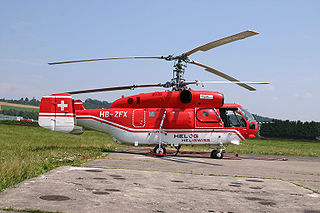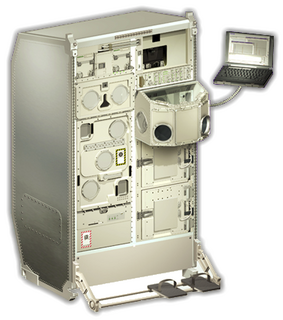
A stepper motor, also known as step motor or stepping motor, is a brushless DC electric motor that divides a full rotation into a number of equal steps. The motor's position can then be commanded to move and hold at one of these steps without any position sensor for feedback, as long as the motor is carefully sized to the application in respect to torque and speed.
GuRoo is a humanoid robot developed at the Mobile Robotics Laboratory in the School of Information Technology and Electrical Engineering at the University of Queensland. The design of the GuRoo is based on the human form and it is kept as anthropomorphic as possible. GuRoo is completely autonomous. It is used for research in different areas including dynamic stability, human-robot interaction and machine learning. GuRoo competes in the annual RoboCup. The goal of this competition is to foster the development of robotics through an annual soccer competition. It is the dream of the RoboCup federation to develop a team of fully autonomous humanoid robots, to play against and beat the human team that wins the World Cup in the year 2050.

A dynamometer or "dyno" for short, is a device for simultaneously measuring the torque and rotational speed (RPM) of an engine, motor or other rotating prime mover so that its instantaneous power may be calculated, and usually displayed by the dynamometer itself as kW or bhp.

Muscle contraction is the activation of tension-generating sites within muscle fibers. In physiology, muscle contraction does not necessarily mean muscle shortening because muscle tension can be produced without changes in muscle length, such as when holding a heavy book or a dumbbell at the same position. The termination of muscle contraction is followed by muscle relaxation, which is a return of the muscle fibers to their low tension-generating state.

The European Physiology Module (EPM) is an International Standard Payload Rack for the Columbus Laboratory on board the International Space Station. The EPM rack was built by OHB-System in Bremen.
The design of spacecraft covers a broad area, including the design of both robotic spacecraft, and spacecraft for human spaceflight.

A linear actuator is an actuator that creates motion in a straight line, in contrast to the circular motion of a conventional electric motor. Linear actuators are used in machine tools and industrial machinery, in computer peripherals such as disk drives and printers, in valves and dampers, and in many other places where linear motion is required. Hydraulic or pneumatic cylinders inherently produce linear motion. Many other mechanisms are used to generate linear motion from a rotating motor.
Inverse dynamics is an inverse problem. It commonly refers to either inverse rigid body dynamics or inverse structural dynamics. Inverse rigid-body dynamics is a method for computing forces and/or moments of force (torques) based on the kinematics (motion) of a body and the body's inertial properties. Typically it uses link-segment models to represent the mechanical behaviour of interconnected segments, such as the limbs of humans, animals or robots, where given the kinematics of the various parts, inverse dynamics derives the minimum forces and moments responsible for the individual movements. In practice, inverse dynamics computes these internal moments and forces from measurements of the motion of limbs and external forces such as ground reaction forces, under a special set of assumptions.

Coaxial rotors or coax rotors are a pair of helicopter rotors mounted one above the other on concentric shafts, with the same axis of rotation, but turning in opposite directions (contra-rotating). This rotor configuration is a feature of helicopters produced by the Russian Kamov helicopter design bureau.
Hypertonia is a term sometimes used synonymously with spasticity and rigidity in the literature surrounding damage to the central nervous system, namely upper motor neuron lesions. Impaired ability of damaged motor neurons to regulate descending pathways gives rise to disordered spinal reflexes, increased excitability of muscle spindles, and decreased synaptic inhibition. These consequences result in abnormally increased muscle tone of symptomatic muscles. Some authors suggest that the current definition for spasticity, the velocity-dependent over-activity of the stretch reflex, is not sufficient as it fails to take into account patients exhibiting increased muscle tone in the absence of stretch reflex over-activity. They instead suggest that "reversible hypertonia" is more appropriate and represents a treatable condition that is responsive to various therapy modalities like drug and/or physical therapy.

Biolab is a single-rack multi-user science payload designed for use in the Columbus laboratory of the International Space Station. Biolab support biological research on small plants, small invertebrates, microorganisms, animal cells, and tissue cultures. It includes an incubator equipped with centrifuges in which the preceding experimental subjects can be subjected to controlled levels of accelerations.
In an isotonic contraction, tension remains the same, whilst the muscle's length changes. Isotonic contractions differ from isokinetic contractions in that in isokinetic contractions the muscle speed remains constant. While superficially identical, as the muscle's force changes via the length-tension relationship during a contraction, an isotonic contraction will keep force constant while velocity changes, but an isokinetic contraction will keep velocity constant while force changes. A near isotonic contraction is known as Auxotonic contraction.

Muscle is a soft tissue found in most animals. Muscle cells contain protein filaments of actin and myosin that slide past one another, producing a contraction that changes both the length and the shape of the cell. Muscles function to produce force and motion. They are primarily responsible for maintaining and changing posture, locomotion, as well as movement of internal organs, such as the contraction of the heart and the movement of food through the digestive system via peristalsis.
Sports biomechanics is a quantitative based study and analysis of professional athletes and sports activities in general. It can simply be described as the physics of sports. In this subfield of biomechanics the laws of mechanics are applied in order to gain a greater understanding of athletic performance through mathematical modeling, computer simulation and measurement. Biomechanics is the study of the structure and function of biological systems by means of the methods of mechanics. Within mechanics there are two sub-fields of study: statics, which is the study of systems that are in a state of constant motion either at rest or moving with a constant velocity; and dynamics, which is the study of systems in motion in which acceleration is present, which may involve kinematics and kinetics. Sports biomechanists help people obtain optimal muscle recruitment and performance. A biomechanist also uses their knowledge to apply proper load barring techniques to preserve the body.

Human Research Facility 1 (HRF-1) on board the International Space Station (ISS) allows investigators to study the effects of long-duration space flight on the human body. Equipment in the HRF-1 includes a clinical ultrasound and a device for measuring mass.
An eccentric contraction is the motion of an active muscle while it is lengthening under load. Eccentric training is repetitively doing eccentric muscle contractions. For example, in a biceps curl the action of lowering the dumbbell back down from the lift is the eccentric phase of that exercise — as long as the dumbbell is lowered slowly rather than letting it drop.
Normal aging movement control in humans is about the changes in the muscles, motor neurons, nerves, sensory functions, gait, fatigue, visual and manual responses, in men and women as they get older but who do not have neurological, muscular or neuromuscular disorder. With aging, neuromuscular movements are impaired, though with training or practice, some aspects may be prevented.
Skeletal muscles, particularly postural muscles of the lower limb, undergo atrophy and structural and metabolic alterations during space flight. The relationships between in-flight exercise, muscle changes and performance are not well understood. Efforts should be made to try to understand the current status of in-flight and post-flight exercise performance capacity and what the goals/target areas for protection are with the current in flight exercise program.
Isoinertial denotes a type of resistance used in exercise training which maintains a constant inertia throughout the range of motion, facilitating a constant resistance and maximal muscle force in every angle.

Locomotion in space includes any variety of actions or methods used to move one's body through an environment with microgravity conditions. Locomotion in these conditions is different from locomotion in Earth's gravity. There are many factors that contribute to these differences, and they are crucial when researching long-term survival of humans in space.










